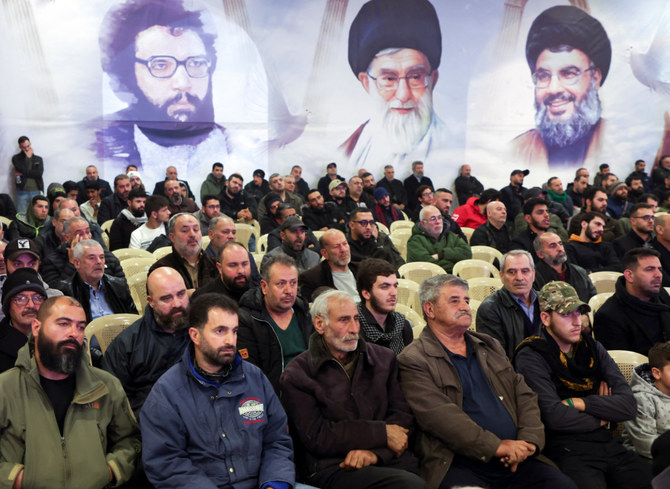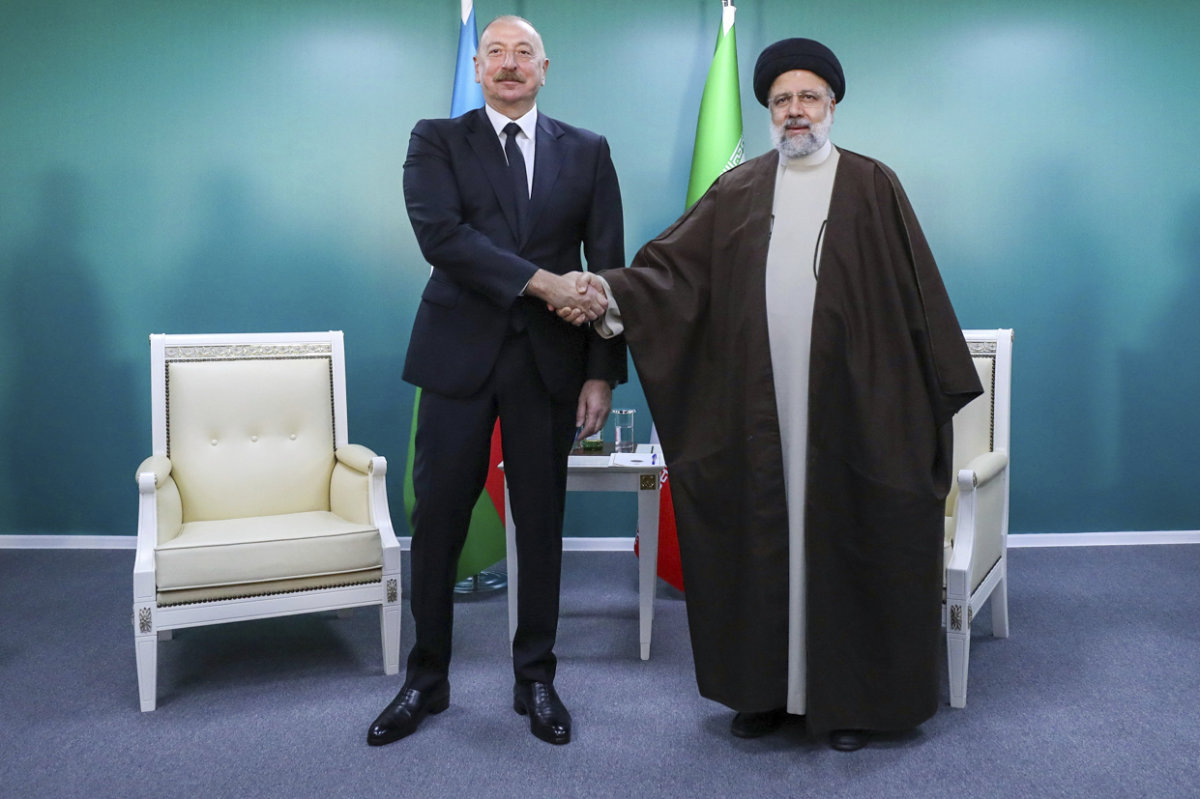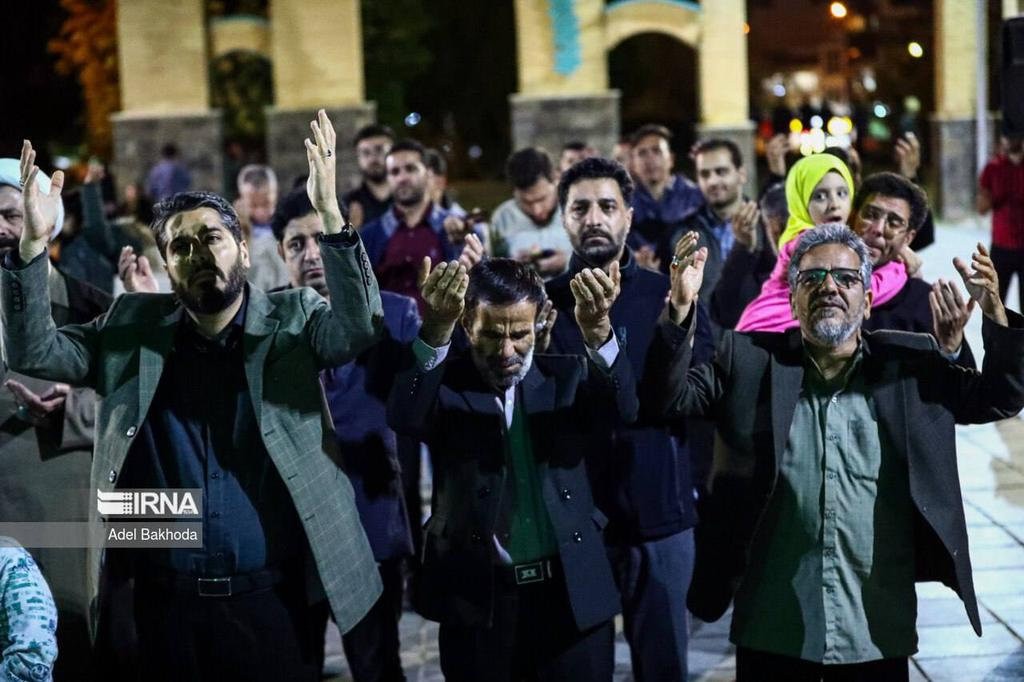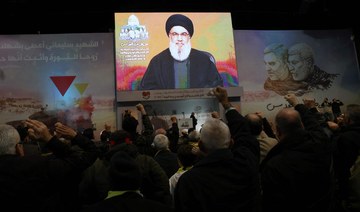BEIRUT: Hezbollah fired dozens of rockets from Lebanon into northern Israel on Saturday, warning that the barrage was its initial response to the targeted killing, presumably by Israel, of a top Hamas leader in Lebanon’s capital earlier this week.
The rocket attack came a day after Hezbollah leader Sayyed Hassan Nasrallah said his group must retaliate for the killing of Saleh Arouri, the deputy political leader of the militia’s ally Hamas, in a Hezbollah stronghold south of Beirut. He said if Hezbollah did not strike back, all of Lebanon would be vulnerable to Israeli attack. He appeared to be making his case for a response to the Lebanese public, even at the risk of escalating the fighting between Hezbollah and Israel as the war between Israel and Hamas rages on.
Hezbollah said it launched 62 rockets toward an Israeli air surveillance base on Mount Meron and that it scored direct hits. It said rockets also struck two army posts near the border. The Israeli military said about 40 rockets were fired toward Meron and that a base was targeted, but made no mention of the base being hit. It said it struck the Hezbollah cell that fired the rockets.
Israeli airstrikes on southern Lebanon hit the outskirts of Kouthariyeh Al-Siyad village, about 40 kilometers (25 miles) from the border, Lebanon’s state-run National News Agency said, adding that there were casualties. Such strikes deeper inside Lebanon have been rare since the border fighting started nearly three months ago. NNA also said Israeli forces shelled border areas including the town of Khiam. Israel’s army had no immediate comment.
Separately, the armed wing of the Islamic Group in Lebanon, the country’s branch of the Muslim Brotherhood and a close ally of Hamas, said it fired two volleys of rockets toward the Israeli city of Kiryat Shmona on Friday night. Two of the group’s members were killed in the strike that killed Arouri.
The cross-border escalation came as US Secretary of State Antony Blinken was kicking off an urgent Middle East diplomatic tour, his fourth to the region since the Israel-Hamas war erupted three months ago. The war was triggered by a deadly Hamas attack on southern Israel in which militants killed about 1,200 people, mostly civilians, and took roughly 250 hostages.
In recent weeks, Israel has been scaling back its military assault in northern Gaza and pressing its heavy offensive in the territory’s south, vowing to crush Hamas. In the south, most of Gaza’s 2.3 million Palestinians are being squeezed into smaller areas in a humanitarian disaster while still being pounded by Israeli airstrikes.
On Saturday, the Health Ministry in Hamas-run Gaza said 122 Palestinians had been killed over the past 24 hours, bringing the total since the start of the war to 22,722. The count does not differentiate between combatants and civilians. The ministry has said two-thirds of those killed have been women or children. The overall number of wounded rose to 58,166, the ministry said.
The Al-Aqsa Martyrs hospital in the central city of Deir Al-Balah received at least 46 bodies overnight, according to hospital records seen by The Associated Press. Many were men who apparently had been shot. Fighting has raged between Israeli forces and militants in the area. The dead also included five members of a family who were killed in an airstrike, the records showed.
The latest Israeli-dropped leaflets urged Palestinians in some areas near the hospital to evacuate, citing “dangerous fighting.”
In the southern Gaza city of Khan Younis, the focus of Israel’s ground offensive, the European Hospital received the bodies of 18 people who were killed in an overnight airstrike on a house in the city’s Maan neighborhood, said Saleh Al-Hamms, head of the hospital’s nursing department. Citing witnesses, he said more than three dozen people had been sheltering in the house, including some who had been displaced.
Israel has held Hamas responsible for civilian casualties, saying the group has embedded itself within Gaza’s civilian infrastructure. Still, international criticism of Israel’s conduct in the war has grown because of the rising civilian death toll. The United States has urged Israel to do more to prevent harm to civilians, even as it keeps sending weapons and munitions while shielding its close ally against international censure.
Blinken began his latest Mideast trip in Turkiye on Saturday. The Biden administration believes Turkiye and others can exert influence, particularly on Iran and its proxies, to tamp down fears of a regional conflagration. Those fears have spiked in recent days with incidents in the Red Sea, Lebanon, Iraq and Iran.
In talks with Turkish President Recep Tayyip Erdogan and Foreign Minister Hakan Fidan, Blinken sought Turkish support for nascent plans for post-war Gaza that could include monetary or in-kind contributions to reconstruction efforts and some form of participation in a proposed multinational force that could operate in or adjacent to the territory.
From Turkiye, Blinken was traveling to Turkish rival and fellow NATO ally Greece to meet Prime Minister Kyriakos Mitsotakis at his home on the island of Crete. Mitsotakis and his government have been supportive of US efforts to prevent the Israel-Hamas war from spreading and have signaled their willingness to assist should the situation deteriorate.
Other stops on the trip include Jordan, followed by Qatar and UAE. Blinken will visit Israel and the West Bank next week before wrapping up the trip in Egypt.
The European Union’s foreign policy chief said during a visit to Beirut that he aims to jump-start a European-Arab initiative to revive a peace process that would result in a two-state solution to the Israeli-Palestinian conflict.
Hezbollah fires at Israel army base after Hamas deputy killing
https://arab.news/5e2uf
Hezbollah fires at Israel army base after Hamas deputy killing

- Hezbollah leader vowed retaliation for suspected Israeli strike in Beirut
- First strike by Israel in Lebanese capital since 2006 killed Hamas’ deputy political leader Saleh Arouri
India’s Modi says ‘deeply saddened and shocked’ by Raisi’s death

- ‘My heartfelt condolences to his family and the people of Iran’
“My heartfelt condolences to his family and the people of Iran,” Modi posted on X, formerly Twitter. “India stands with Iran in this time of sorrow.”
Iran’s president, foreign minister and others found dead at helicopter crash site, state media says

- “We can see the wreckage and the situation does not look good,” Red Crescent official said
- Turkish drone footage suggesting the helicopter went down in the mountains
DUBAI: Iranian President Ebrahim Raisi, the country’s foreign minister and others have been found dead at the site of a helicopter crash Monday after an hourslong search through a foggy, mountainous region of the country’s northwest, state media reported. Raisi was 63.
The crash comes as the Middle East remains unsettled by the Israel-Hamas war, during which Raisi under Supreme Leader Ayatollah Ali Khamenei launched an unprecedented drone-and-missile attack on Israel just last month. Under Raisi, Iran enriched uranium closer than ever to weapons-grade levels, further escalating tensions with the West as Tehran also supplied bomb-carrying drones to Russia for its war in Ukraine and armed militia groups across the region.
Meanwhile, Iran has faced years of mass protests against its Shiite theocracy over its ailing economy and women’s rights – making the moment that much more sensitive for Tehran and the future of the country.
State TV gave no immediate cause for the crash in Iran’s East Azerbaijan province. Among the dead was Iranian Foreign Minister Hossein Amirabdollahian, 60.

Raisi was traveling in Iran’s East Azerbaijan province. State TV said what it called a “hard landing” happened near Jolfa, a city on the border with the nation of Azerbaijan, some 600 kilometers (375 miles) northwest of the Iranian capital, Tehran. Later, state TV put it farther east near the village of Uzi, but details remained contradictory.
With Raisi were Iran’s Foreign Minister Hossein Amirabdollahian, the governor of Iran’s East Azerbaijan province and other officials and bodyguards, the state-run IRNA news agency reported. One local government official used the word “crash,” but others referred to either a “hard landing” or an “incident.”
Early Monday morning, Turkish authorities released what they described as drone footage showing what appeared to be a fire in the wilderness that they “suspected to be wreckage of helicopter.” The coordinates listed in the footage put the fire some 20 kilometers (12 miles) south of the Azerbaijan-Iranian border on the side of a steep mountain.

Footage released by the IRNA early Monday showed what the agency described as the crash site, across a steep valley in a green mountain range. Soldiers speaking in the local Azeri language said: “There it is, we found it.”
Shortly after, state TV in an on-screen scrolling text said: “There is no sign of live from people on board.” It did not elaborate, but the semiofficial Tasnim news agency showed rescuers using a small drone to fly over the site, with them speaking among themselves saying the same thing.
Religious leaders had urged the public to pray. State TV aired images of hundreds of the faithful, some with their hands outstretched in supplication, praying at Imam Reza Shrine in the city of Mashhad, one of Shiite Islam’s holiest sites, as well as in Qom and other locations across the country. State television’s main channel aired the prayers nonstop.
In Tehran, a group of men kneeling on the side of the street clasped strands of prayer beads and watched a video of Raisi praying, some of them visibly weeping.
“If anything happens to him we’ll be heartbroken,” said one of the men, Mehdi Seyedi. ”May the prayers work and may he return to the arms of the nation safe and sound.”

IRNA called the area a “forest” and the region is known to be mountainous as well. State TV aired images of SUVs racing through a wooded area and said they were being hampered by poor weather conditions, including heavy rain and wind. Rescuers could be seen walking in the fog and mist.
Khamenei himself also urged the public to pray.
“We hope that God the Almighty returns the dear president and his colleagues in full health to the arms of the nation,” Khamenei said, drawing an “amen” from the worshipers he was addressing.
However, the supreme leader also stressed the business of Iran’s government would continue no matter what. Under the Iranian constitution, Iran’s vice first president takes over if the president dies with Khamenei’s assent, and a new presidential election would be called within 50 days. First Vice President Mohammad Mokhber already had begun receiving calls from officials and foreign governments in Raisi’s absence, state media reported.
Raisi, 63, a hard-liner who formerly led the country’s judiciary, is viewed as a protégé of Khamenei and some analysts have suggested he could replace the 85-year-old leader after Khamenei’s death or resignation.

Raisi had been on the border with Azerbaijan early Sunday to inaugurate a dam with Azerbaijan’s President Ilham Aliyev. The dam is the third one that the two nations built on the Aras River. The visit came despite chilly relations between the two nations, including over a gun attack on Azerbaijan’s Embassy in Tehran in 2023, and Azerbaijan’s diplomatic relations with Israel, which Iran’s Shiite theocracy views as its main enemy in the region.
Iran flies a variety of helicopters in the country, but international sanctions make it difficult to obtain parts for them. Its military air fleet also largely dates back to before the 1979 Islamic Revolution. IRNA published images it described as Raisi taking off in what resembled a Bell helicopter, with a blue-and-white paint scheme previously seen in published photographs.

Raisi won Iran’s 2021 presidential election, a vote that saw the lowest turnout in the Islamic Republic’s history. Raisi is sanctioned by the US in part over his involvement in the mass execution of thousands of political prisoners in 1988 at the end of the bloody Iran-Iraq war.
Under Raisi, Iran now enriches uranium at nearly weapons-grade levels and hampers international inspections. Iran has armed Russia in its war on Ukraine, as well as launched a massive drone-and-missile attack on Israel amid its war against Hamas in the Gaza Strip. It also has continued arming proxy groups in the Mideast, like Yemen’s Houthi rebels and Lebanon’s Hezbollah.
Meanwhile, mass protests in the country have raged for years. The most recent involved the 2022 death of Mahsa Amini, a woman who had been earlier detained over allegedly not wearing a hijab, or headscarf, to the liking of authorities. The monthslong security crackdown that followed the demonstrations killed more than 500 people and saw over 22,000 detained.
In March, a United Nations investigative panel found that Iran was responsible for the “physical violence” that led to Amini’s death.
Moroccans in pro-Palestinian march rally against Israel ties

- Rabat has officially denounced what it said were “flagrant violations of the provisions of international law” by Israel in its war against Hamas, but has not given any indication that normalization with Israel would be undone
- Israel has killed at least 35,456 people in Gaza, also mostly civilians, according to data provided by the Hamas-run territory’s health ministry
CASABLANCA, Morocco: Thousands of Moroccans demonstrated Sunday in Casablanca in support of the Palestinian people and against ties with Israel, an AFP journalist said, more than seven months into the Gaza war.
Protesters in Morocco’s commercial capital chanted “Freedom for Palestine,” “If we don’t speak out, who will?” and “No to normalization,” and many wore keffiyeh scarves or waved Palestinian flags.
The North African kingdom established diplomatic ties with Israel in late 2020 under the US-brokered Abraham Accords which saw similar moves by the United Arab Emirates and Bahrain.
Under the deal, the United States recognized Morocco’s claim to sovereignty over the disputed territory of Western Sahara.
Since the Israel-Hamas war in the Gaza Strip began on October 7, large-scale demonstrations in Morocco have called for the abrogation of the normalization accord.
On Sunday, the demonstrators marched through central Casablanca in a protest called by a grouping of leftist parties and Islamist movements.
“I cannot remain indifferent and silent in the face of what is happening to the Palestinians who are being killed on a daily basis,” demonstrator Zahra Bensoukar, 43, told AFP.
Idriss Amer, 48, said he was protesting “in solidarity with the Palestinian people, against the Zionist massacre in Gaza and against normalization” of ties with Israel.
Rabat has officially denounced what it said were “flagrant violations of the provisions of international law” by Israel in its war against Hamas, but has not given any indication that normalization with Israel would be undone.
The Gaza war broke out after Hamas on October 7 launched an unprecedented attack on Israel which resulted in the deaths of more than 1,170 people, mostly civilians, according to an AFP tally based on Israeli official figures.
Israel’s retaliatory offensive has killed at least 35,456 people in Gaza, also mostly civilians, according to data provided by the Hamas-run territory’s health ministry.
Hamas also took about 250 hostages on October 7, of whom 124 remain held in Gaza including 37 the Israeli military says are dead.
What do we know so far about the mysterious crash of the helicopter carrying Iran’s president?

- Initially, Interior Minister Ahmad Vahidi said the helicopter “was forced to make a hard landing due to the bad weather and fog”
BEIRUT: The apparent crash of a helicopter carrying Iran’s president and foreign minister on Sunday sent shock waves around the region.
Details remained scant in the hours after the incident, and it was unclear if Iranian President Ebrahim Raisi and the other officials had survived.
Here’s what we know so far.
WHO WAS ON BOARD THE HELICOPTER AND WHERE WERE THEY GOING?
The helicopter was carrying Iranian President Ebrahim Raisi, the country’s Foreign Minister Hossein Amirabdollahian, the governor of Iran’s East Azerbaijan province and other officials and bodyguards, according to the state-run IRNA news agency. Raisi was returning from a trip to Iran’s border with Azerbaijan earlier Sunday to inaugurate a dam with Azerbaijan’s President Ilham Aliyev, the news agency said.
WHERE AND HOW DID THE HELICOPTER GO DOWN?
The helicopter apparently crashed or made an emergency landing in the Dizmar forest between the cities of Varzaqan and Jolfa in Iran’s East Azerbaijan province, near its border with Azerbaijan, under circumstances that remain unclear. Initially, Interior Minister Ahmad Vahidi said the helicopter “was forced to make a hard landing due to the bad weather and fog.”
WHAT IS THE STATUS OF THE SEARCH OPERATIONS?
Iranian officials have said the mountainous, forested terrain and heavy fog impeded search-and-rescue operations. The president of the Iranian Red Crescent Society, Pir-Hossein Koulivand, said 40 search teams were on the ground in the area despite “challenging weather conditions.” The search is being done by teams on the ground, as “the weather conditions have made it impossible to conduct aerial searches” via drones, Koulivand said, according to IRNA.
IF RAISI DIED IN THE CRASH, HOW MIGHT THIS IMPACT IRAN?
Raisi is seen as a protégé to Iran’s supreme leader Ayatollah Ali Khamenei and a potential successor for his position within the country’s Shiite theocracy. Under the Iranian constitution, if he died, the country’s first vice president, Mohammad Mokhber, would become president. Khamenei has publicly assured Iranians that there would be “no disruption to the operations of the country” as a result of the crash.
WHAT HAS THE INTERNATIONAL REACTION BEEN?
Countries including Russia, Iraq and Qatar have made formal statements of concern about Raisi’s fate and offered to assist in the search operations.
Azerbaijani President Aliyev said he was “deeply concerned” to hear of the incident, and affirmed that Azerbaijan was ready to provide any support necessary. Relations between the two countries have been chilly due to Azerbaijan’s diplomatic relations with Israel, Iran’s regional arch-enemy.
There was no immediate official reaction from Israel. Last month, following an Israeli strike on an Iranian consular building in Damascus that killed two Iranian generals, Tehran launched hundreds of missiles and drones at Israel. They were mostly shot down and tensions have apparently since subsided.
EU Red Sea mission says it defended 120 ships from Houthi attacks

- Human rights activist raps cases of prisoner fatalities as a result of torture in militia’s captivity
AL-MUKALLA, Yemen: The EU mission in the Red Sea, known as EUNAVFOR Aspides, said on Sunday that it had protected over 100 ships while sailing the critical trade channel and shot down more than a dozen Houthi missiles and drones in the last three months.
In a post on X marking three months since the start of its operation, the EU mission, which is now made up of five naval units and 1,000 personnel from 19 contributing nations, said that its forces had destroyed 12 drones, one drone boat, and four ballistic missiles fired by the Houthis from areas under their control in Yemen, as well as provided protection to 120 commercial ships since February.
“Great day for Freedom of Navigation, as 3 months have passed since the launch of ASPIDES. Three months of multiple challenges and great achievements. ASPIDES continues its mission in full compliance with international law, to ensure maritime security and seaborne trade,” EUNAVFOR Aspides said.
On Feb. 19, the EU announced the commencement of EUNAVFOR Aspides, a military operation in the Red Sea to defend international marine traffic against Houthi attacks.
At the same time, the Philippines Department of Migrant Workers said on Sunday that 23 of its citizens who were aboard the oil ship assaulted by Houthi militia in the Red Sea on Saturday were safe.
“The DMW is closely coordinating with international maritime authorities, shipping companies, and local manning agencies on the status of ships with Filipino seafarers traversing high-risk areas and war-like zones in the Red Sea and the Gulf of Aden,” the DMW said in a statement carried by the official Philippine News Agency.
For seven months, the Houthis have launched hundreds of ballistic missiles, drones, and drone boats against commercial and navy ships along international commerce lanes off Yemen, including the Red Sea.
The Houthis claim that their strikes are intended to push Israel to cease the war in Gaza and allow humanitarian supplies into the Palestinian territory.
Three civilian sailors, including two Filipinos, were killed in March after the Houthis launched a missile at their ship in the Red Sea.
Many international shipping companies directed their ships to avoid the Red Sea and other passages off Yemen, opting for longer and more costly routes through Africa.
Meanwhile, Yemen human rights activists have said that a man held by the Houthis during the last seven years died as a result of abuse in Houthi imprisonment, making him the latest victim of torture within Houthis detention facilities.
On Saturday, the Houthis told the family of Najeed Hassan Farea in Taiz through the Yemen Red Crescent that their son had died in their custody, but they did not explain how.
The Houthis abducted Farea in February 2017 after storming his village and home in the Al-Taziya district, preventing him from contacting his family and denying them information about where he was being detained.
Eshraq Al-Maqtari, a human rights activist in Taiz who reached Farea’s family, told Arab News that the Houthis cruelly tortured the man and that his family was stunned to hear of his death after years of information blackout since his detention.
“He was denied the right to communicate, to know his fate, and the right to healthcare, which appears to have caused his death,” she said, adding that since the start of the year, there have been three verified cases of prisoner fatalities as a result of torture in Houthi captivity.






















